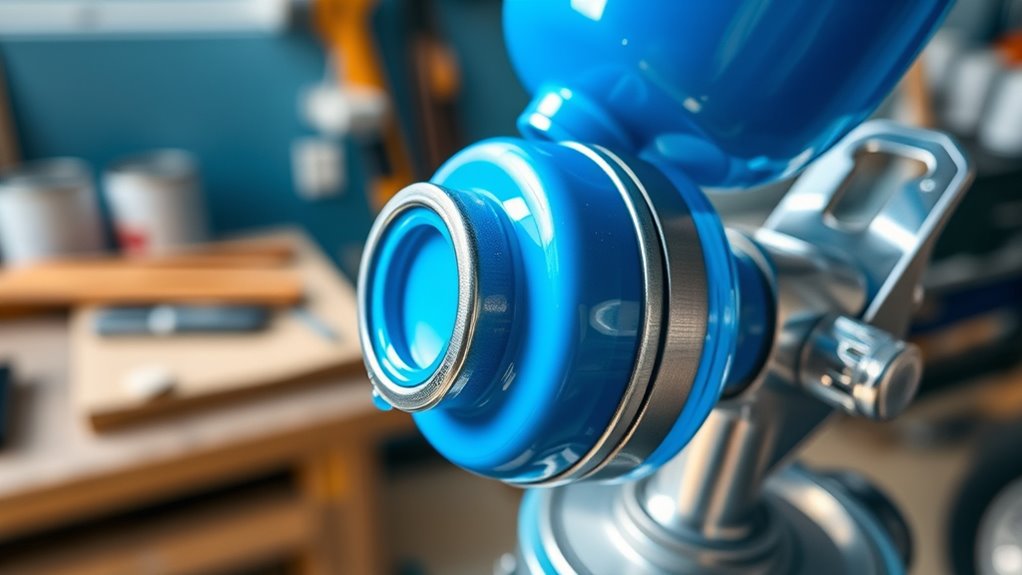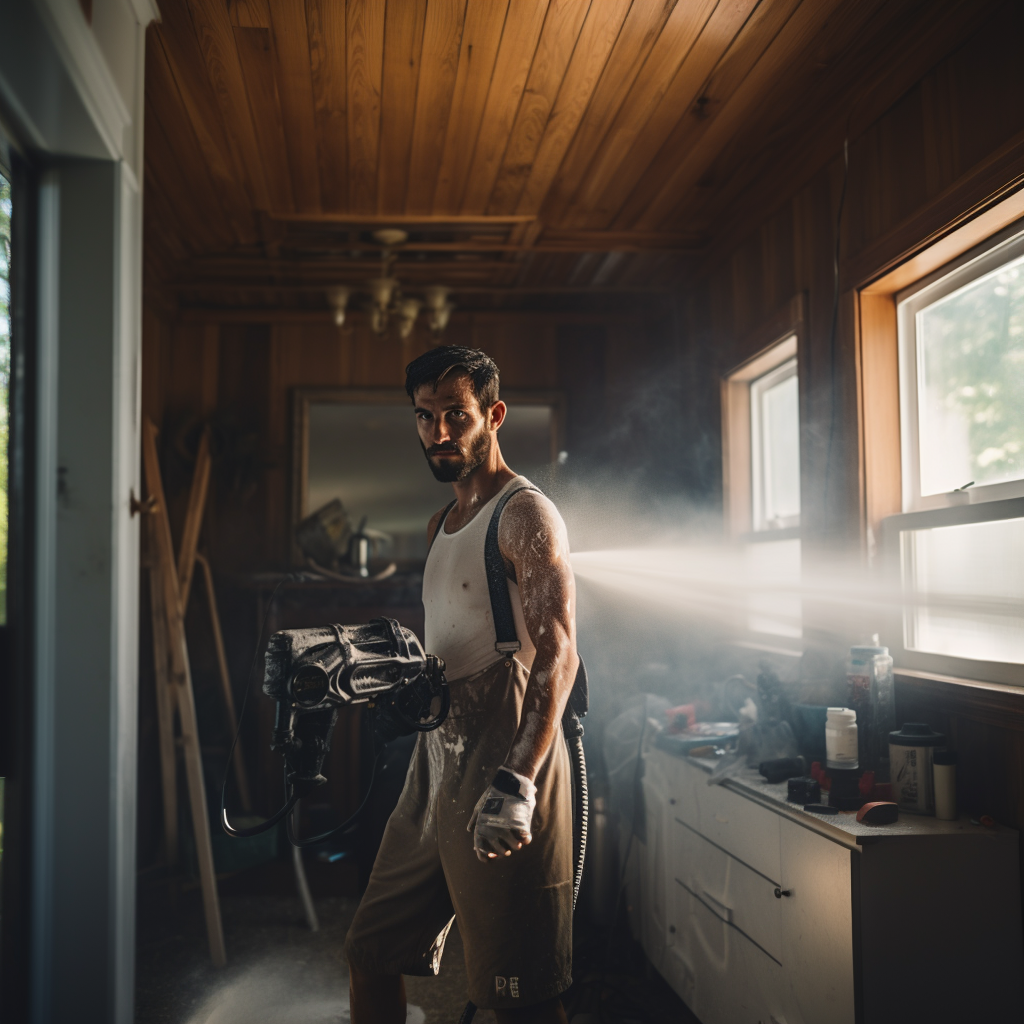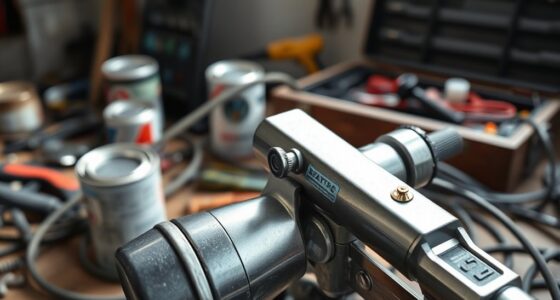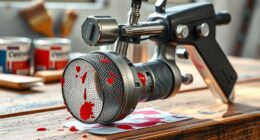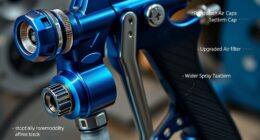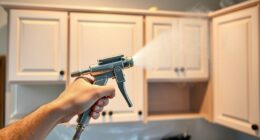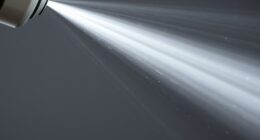You can usually leave paint in a paint sprayer for about 15 to 30 minutes without risking clogs or drying, especially if you manage it properly. Water-based paints tend to skin over faster, so quick cleaning or sealing the nozzle helps. Oil-based paints last a bit longer if stored correctly. To avoid issues, it’s best to flush and cover the sprayer during short pauses. For those planning longer breaks, there are important steps to follow—keep going to learn more.
Key Takeaways
- Water-based paints can dry or skin over within 1-2 hours inside the sprayer, risking clogs if left unattended.
- Oil-based paints remain workable longer but should be cleaned within 24 hours to prevent curing and clogging.
- Short breaks of 15-30 minutes can be managed by sealing the nozzle or flushing with solvent to prevent drying.
- For extended pauses, it’s best to thoroughly clean and store the sprayer to avoid paint curing or clogging inside the equipment.
- Leaving paint in the sprayer overnight or longer often leads to drying, hardened nozzle blocks, and potential internal damage.

If you need to take a break during a painting project, you might wonder how long you can leave paint in your sprayer without causing issues. The answer depends on the type of paint you’re using and how long the sprayer remains idle. Generally, water-based paints tend to dry faster inside the sprayer, increasing the risk of clogging if left for too long. Oil-based paints, on the other hand, can sometimes stay workable longer, but they still require proper care to avoid drying out or thickening. To prevent problems, it’s crucial to understand cleaning tips and storage precautions when pausing your work.
If you plan to stop for a short period, say 15-30 minutes, some sprayers have built-in features like reversible tips or quick-clean settings that can help you manage the paint. For longer breaks, you should take steps to protect the paint from drying and the sprayer from clogs. One effective cleaning tip involves flushing the paint out of the gun with an appropriate solvent or water (depending on the paint type) and then sealing the nozzle with plastic wrap or a special cap. This prevents the paint from skinning over or drying inside the nozzle, which can cause blockages when you resume painting.
Storage precautions are equally important. If you’re leaving the paint in the sprayer for an extended period—say, overnight—you need to take extra care. First, empty the paint container if possible, especially if you’re using water-based or latex paint, as it dries quickly. If you must leave paint inside, thoroughly clean the sprayer to remove residual paint and then store it in a cool, dry place. Some sprayers have storage caps or covers; use them to keep dust and debris out and prevent the paint from curing inside the equipment. Never leave the sprayer in direct sunlight or in a hot environment, as high temperatures accelerate drying and may damage internal components.
Frequently Asked Questions
Can Leftover Paint in the Sprayer Cause Damage Over Time?
Leftover paint in your sprayer can cause damage over time if not cleaned properly. It may lead to paint separation, making future spraying difficult, and can cause equipment corrosion from dried residue or chemical buildup. Regularly cleaning your sprayer after use prevents these issues, ensuring it functions smoothly and lasts longer. Don’t ignore leftover paint, as neglecting it risks costly repairs and reduced performance over time.
How Does Temperature Affect Paint Drying in a Sprayer?
You might wonder about the temperature impact on your paint drying rate in a sprayer. Warmer temperatures accelerate the drying process, letting your paint cure faster. Conversely, cooler temperatures slow down drying, increasing the risk of clogs or uneven finish. To guarantee the best results, keep your workspace at a consistent, moderate temperature. This helps maintain a steady drying rate, preventing issues caused by temperature fluctuations.
Is It Safe to Reuse Paint Left Overnight in the Sprayer?
You might wonder if it’s safe to reuse paint left overnight in your sprayer. It’s generally okay if you properly store it; cover the container tightly and keep it in a cool, dry place. However, for the best results, you should always do sprayer cleaning before reuse, as leftover paint can clog or damage your equipment. Proper paint storage guarantees you avoid waste and maintain your sprayer’s performance.
What Types of Paint Are More Prone to Clogging?
Imagine your paint as a delicate dance partner—some types are more prone to missteps. Thicker paints with inconsistent paint consistency tend to clog your sprayer more often, especially if you have a small nozzle size. Latex and oil-based paints, when not properly thinned, can block the nozzle faster. To keep things running smoothly, always match paint type and consistency to your sprayer’s nozzle size.
How Can I Prevent Paint From Drying Inside the Spray Gun?
To prevent paint from drying inside your spray gun, focus on proper paint storage and cleaning techniques. Immediately after use, flush the system with solvent or water, depending on your paint type, to clear residual paint. Store leftover paint in airtight containers, and avoid leaving paint in the gun for extended periods. Regularly clean your spray gun thoroughly to prevent buildup and clogs, ensuring it stays in good working condition for future projects.
Conclusion
If you’re not planning to use your paint sprayer right away, it’s best to give it a gentle pause rather than a long rest. Think of it as putting your tools in a cozy, temporary lull—just enough to keep everything fresh and ready for your next creative burst. With a little care and timely cleaning, your sprayer will be a reliable partner, always prepared to bring your vision to life without the worry of unwanted hiccups along the way.
Franz came aboard the Paint Sprayer Zone team with a background in both journalism and home renovation. His articulate writing style, combined with a passion for DIY projects, makes him an invaluable asset. Franz has a knack for breaking down technical jargon into easy-to-understand content, ensuring that even the most novice of readers can grasp the complexities of paint sprayers.
